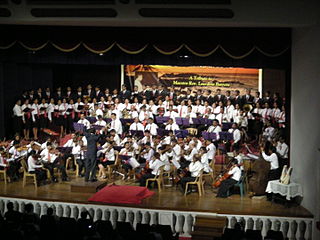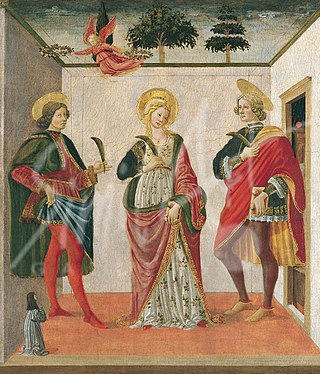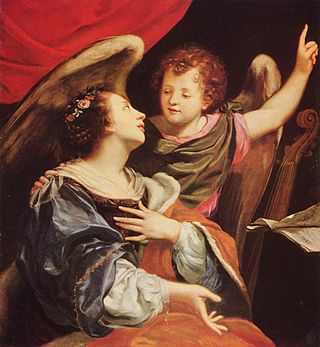
Agnes of Rome is a virgin martyr, venerated as a saint in the Catholic Church, Oriental Orthodox Church and the Eastern Orthodox Church, as well as the Anglican Communion and Lutheran Churches. She is one of several virgin martyrs commemorated by name in the Canon of the Mass, and one of many Christians martyred during the reign of the Roman emperor Diocletian.

Pope Lucius I was the bishop of Rome from 25 June 253 to his death on 5 March 254. He was banished soon after his consecration, but gained permission to return. He was mistakenly classified as a martyr in the persecution by Emperor Valerian, which did not begin until after Lucius' death.

The calendar of saints is the traditional Christian method of organizing a liturgical year by associating each day with one or more saints and referring to the day as the feast day or feast of said saint. The word "feast" in this context does not mean "a large meal, typically a celebratory one", but instead "an annual religious celebration, a day dedicated to a particular saint".

Saint Lawrence or Laurence was one of the seven deacons of the city of Rome under Pope Sixtus II who were martyred in the persecution of the Christians that the Roman Emperor Valerian ordered in 258.

Lucia of Syracuse (283–304), also called Saint Lucia was a Roman Christian martyr who died during the Diocletianic Persecution. She is venerated as a saint in Catholic, Anglican, Lutheran, and Eastern Orthodox Christianity. She is one of eight women explicitly commemorated by Catholics in the Canon of the Mass. Her traditional feast day, known in Europe as Saint Lucy's Day, is observed by Western Christians on 13 December. Lucia of Syracuse was honored in the Middle Ages and remained a well-known saint in early modern England. She is one of the best known virgin martyrs, along with Agatha of Sicily, Agnes of Rome, Cecilia of Rome, and Catherine of Alexandria.

Saint Apollonia was one of a group of virgin martyrs who suffered in Alexandria during a local uprising against the Christians prior to the persecution of Decius. According to church tradition, her torture included having all of her teeth violently pulled out or shattered. For this reason, she is popularly regarded as the patroness of dentistry and those suffering from toothache or other dental problems. French court painter Jehan Fouquet painted the scene of St. Apollonia's torture in The Martyrdom of St. Apollonia.

Agathaof Sicily is a Christian saint. Her feast is on 5 February. Agatha was born in Catania, part of the Roman Province of Sicily, and was martyred c. 251. She is one of several virgin martyrs who are commemorated by name in the Canon of the Mass.

The Litany of the Blessed Virgin Mary is a Marian litany originally approved in 1587 by Pope Sixtus V. It is also known as the Litany of Loreto, after its first-known place of origin, the Shrine of Our Lady of Loreto (Italy), where its usage was recorded as early as 1558.

Santa Cecilia in Trastevere is a 5th-century church in Rome, Italy, in the Trastevere rione, devoted to the Roman martyr Saint Cecilia.

The Accademia Nazionale di Santa Cecilia is one of the oldest musical institutions in the world, founded by the papal bull Ratione congruit, issued by Sixtus V in 1585, which invoked two saints prominent in Western musical history: Gregory the Great, for whom the Gregorian chant is named, and Saint Cecilia, the patron saint of music. Since 2005 it has been headquartered at the Renzo Piano designed Parco della Musica in Rome.

Eugenia of Rome was an early Christian Roman martyr whose feast day is celebrated on December 25 in the Roman Catholic Church, on December 24 in the Eastern Catholic Churches and Eastern Orthodox Church, and on January 23 in the Armenian Apostolic Church. She is included in the Golden Legend.
Hail! Bright Cecilia (Z.328), also known as Ode to St. Cecilia, was composed by Henry Purcell to a text by the Irishman Nicholas Brady in 1692 in honour of the feast day of Saint Cecilia, patron saint of musicians.

Agrippina of Mineo, also known as Saint Agrippina was venerated as a virgin martyr in the Catholic Church and Orthodox Christianity.

Felicitas of Rome, also anglicized as Felicity, is a saint numbered among the Christian martyrs. Apart from her name, the only thing known for certain about this martyr is that she was buried in the Cemetery of Maximus, on the Via Salaria on a 23 November. However, a legend presents her as the mother of the seven martyrs whose feast is celebrated on 10 July. The Eastern Orthodox Church celebrates their martyrdom on 25 January.

November 21 - Eastern Orthodox liturgical calendar - November 23
Saint Cecilia is the patron saint of musicians and church music in Catholic and Orthodox traditions.

The Santa Cecilia Choir is a polyphonic male choir composed of seminarians of the Rachol Seminary of the Catholic Archdiocese of Goa and Daman in Goa, India.

Saints Tiburtius, Valerian, and Maximus are three Christian martyrs who were buried on 14 April of some unspecified year in the Catacombs of Praetextatus on the Via Appia near Rome.

The Messa di Santa Cecilia is a religious work by Alessandro Scarlatti, written in 1720 for five soloists (SSATB), choir and orchestra, commissioned by and dedicated to cardinal Francesco Acquaviva of Aragona.

St. Cecilia is a Baroque sculpture by Stefano Maderno and commissioned by Cardinal Paolo Emilio Sfrondrato in the church of Santa Cecilia in Trastevere, Rome. Stefano Maderno was a famous Italian sculptor from the early 1600s best known for his statues of saints. St. Cecilia was the Roman saint of music who was executed for baptizing her fellow Romans and as such became a martyr for Christianity. The statue was part of a renovation done to the St. Cecilia Basilica in Trastevere, Rome, which displays the saint lying on her side with her dress tucked between her knees in a Baroque art style as part of an exhibit which also displays a new tomb of St. Cecilia's actual body. The body was moved during Pope Paschal I's campaign to move Christian saints' bodies inside the walls of Rome. The sculpture exists as a Christian symbol of overcoming hatred and prosecution.




































